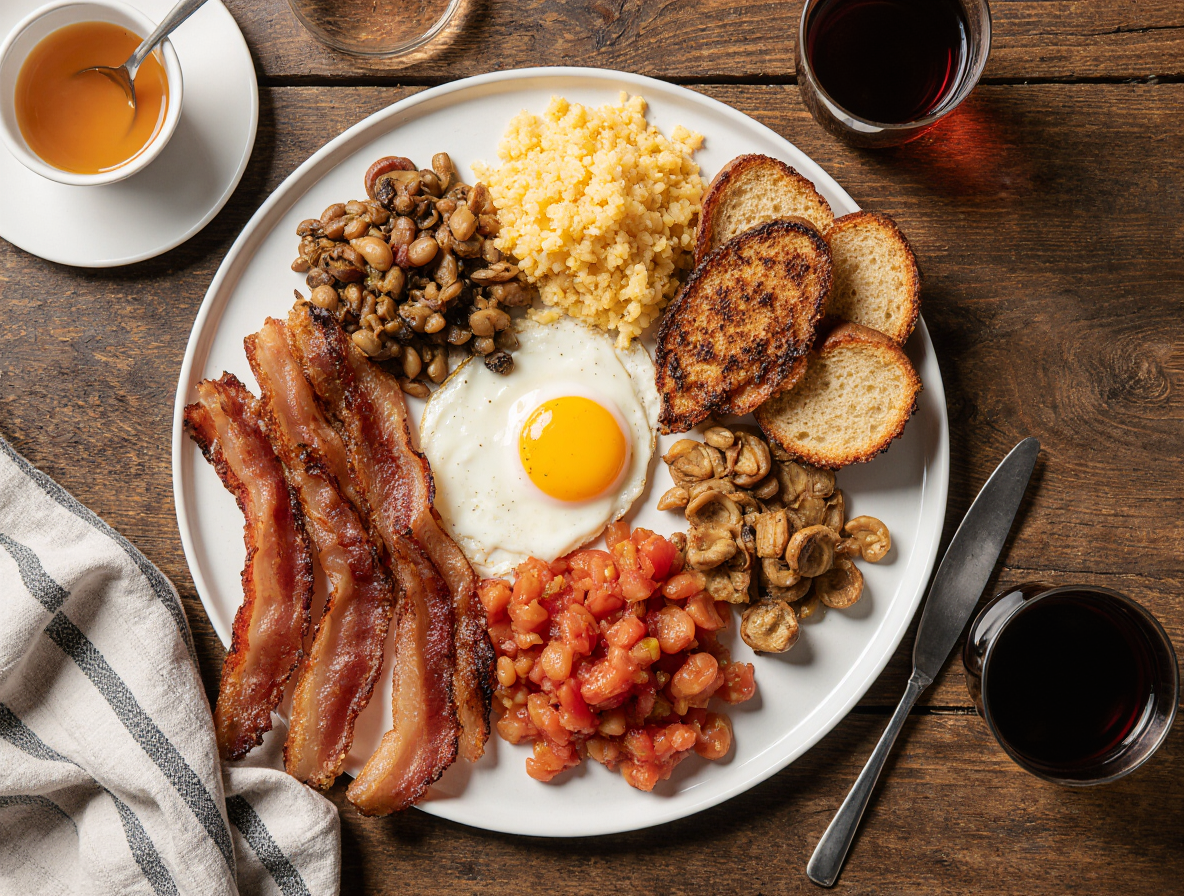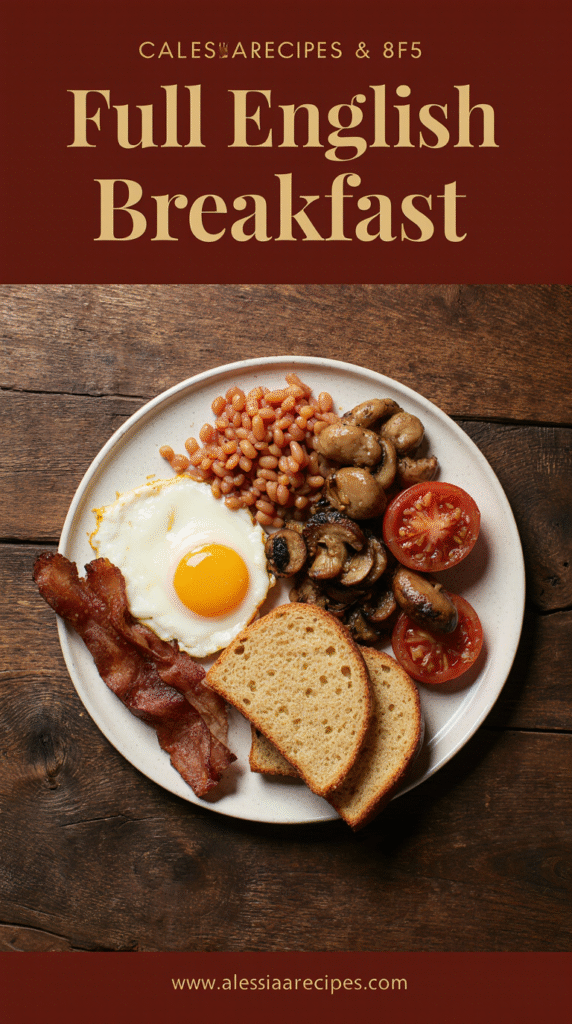How to Make a Full English Breakfast: A Chef’s Secret Guide
Did you know that a full English breakfast packs an astonishing 1684 calories, with over 1000 of those coming from fat alone?
As a chef, I’ve always been fascinated by this iconic meal that’s so beloved it’s typically offered throughout the day as an all-day breakfast option. The traditional English breakfast first gained popularity during the Victorian era, eventually reaching its peak in Edwardian Britain.
What exactly makes up this hearty morning feast? A proper full English breakfast includes back bacon, sausages, eggs, tomatoes, mushrooms, fried bread, and beans. However, many consider the combination of both bacon and sausage to be one of the essential elements that defines a true “fry up.” Additionally, according to a 2017 YouGov poll, more than 50% of ideal full English breakfasts contain bacon, sausage, beans, bread, eggs, hash browns, mushrooms, and tomatoes.
Creating the perfect English breakfast recipe isn’t just about the ingredients—it’s about timing and technique. It actually takes a bit of juggling and two pans, because making a full English is essentially an exercise in multitasking. The runny egg yolk is particularly important as it serves as the sauce that brings the whole plate together!
In this guide, I’ll share my chef’s secrets for creating this traditional meal from selecting the finest ingredients to mastering the cooking sequence that ensures everything arrives hot on the plate at the same time.
What is in a Full English Breakfast?
The traditional full English breakfast represents centuries of British culinary culture. Unlike many breakfast traditions that emphasize simplicity, this iconic meal features a diverse array of hearty components cooked to perfection.
Understanding the traditional components
A traditional full English breakfast includes several key ingredients that have remained consistent throughout its evolution. The core components typically include:
- Back bacon – thicker and juicier than American streaky bacon
- Sausages – often sage-speckled Lincolnshire or Cumberland varieties
- Eggs – fried, poached, or scrambled
- Tomatoes – grilled or fried, sometimes tinned
- Mushrooms – sautéed or fried
- Baked beans – traditionally Heinz in a tomato sauce
- Bread – either toast or fried bread
Black pudding, despite being considered essential by purists, was chosen by only 35% of people in a 2017 YouGov poll. Moreover, regional variations introduce additional elements such as white pudding in northwest England, hog’s pudding in Cornwall and Devon, and hash browns which have become increasingly common.
Why it’s called a ‘Full English’
The term ‘Full English’ is relatively modern, despite the meal’s ancient roots. The name emerged in the early 20th century as an alternative to the “Continental” breakfast of pastries and fruit juices offered to tourists. Furthermore, the “full” descriptor refers to the complete array of traditional English breakfast items served together.
Interestingly, regional variations exist throughout the United Kingdom, including the full Irish, full Scottish, full Welsh, and Ulster fry. Each version incorporates local specialties – the Welsh breakfast includes cockles and laverbread, while the Scottish version features Lorne sausage and tattie scones.
When and where it’s typically served
Originally a meal for the wealthy gentry in the 14th and 15th centuries, the full English breakfast has democratized over time. By the 1950s, approximately half of the British population started their day with this substantial meal.
Today, the full English breakfast is widely available in cafes, pubs, and restaurants throughout the UK, often served as an “all-day breakfast”. Indeed, many establishments offer it from opening until closing time. While once a daily staple, it’s now more commonly enjoyed as an occasional weekend treat, celebration meal, or hangover cure.
Essential Ingredients and How to Choose Them
Selecting quality ingredients is the cornerstone of an exceptional full English breakfast. Each component brings its own character to the plate, creating a symphony of flavors when chosen with care.
Sausages and back bacon
Sausages are often considered the centerpiece of a full English breakfast. For the best results, choose high-quality pork sausages with substantial meat content. Traditional options include sage-infused Lincolnshire sausages, spiced Cumberland sausages shaped in spirals, or simple plain pork bangers. Thicker sausages deliver juicier results, though thinner varieties cook faster—ideal when preparing multiple components simultaneously.
Back bacon is distinctly different from American “streaky” bacon. This quintessentially British cut combines both pork loin and pork belly in one slice, offering the perfect balance of lean meat and fat. The rounded portion is pork loin while the fatty section is pork belly. This unique cut has been perfected over centuries, often using specific pig breeds like Yorkshire and Tamworth that are historically bred for producing perfect back bacon.
Eggs and cooking styles
Eggs should always be cooked last to ensure they arrive hot on the plate. While fried eggs (sunny-side up) are traditional, providing that essential runny yolk that acts as “sauce” for the entire meal, you have several options:
- Fried: Quick and classic, with runny yolks
- Poached: Lighter alternative with beautiful yolk flow
- Scrambled: Best made without milk for purists, just butter and seasonings
Tomatoes, mushrooms, and beans
Tomatoes add essential acidity and sweetness to balance the fatty components. Halve plum tomatoes, season with salt and pepper, then fry cut-side down until softened and slightly caramelized. Fresh is preferable, though tinned tomatoes work when fresh aren’t in season.
For mushrooms, button or chestnut varieties work beautifully. Slice thickly and sauté in butter until golden brown and caramelized for maximum flavor. Mushrooms should be cooked without overcrowding the pan to prevent sweating.
Beans must be Heinz baked beans in tomato sauce—unlike American baked beans which are sweeter and smokier. Interestingly, their integration into the English breakfast dates back to a 1927 Heinz marketing campaign.
Fried bread vs toast
Fried bread is the traditional choice—white bread fried in bacon fat, butter or oil until golden and crispy. It’s substantially more indulgent than toast, requiring generous amounts of fat (about two tablespoons per slice). Toast offers a healthier alternative, though purists may argue it lacks the luxurious quality of proper fried bread.
Optional items: black pudding, bubble and squeak
Black pudding—a blood sausage made with oatmeal and pork fat—is a divisive yet traditional component. It’s typically sliced and fried until crispy outside while remaining soft inside. Despite being controversial, it’s nutrient-rich, particularly in iron and zinc.
Bubble and squeak is essentially leftover vegetables (traditionally cabbage or Brussels sprouts) mixed with mashed potatoes and fried until crispy. The name derives from the bubbling and squeaking sounds it makes while cooking. Proper bubble and squeak adds variety to the plate while honoring the British tradition of resourcefully using leftovers.
How to Make a Full English Breakfast Step-by-Step
The magic of a full English breakfast lies in its preparation sequence. Getting everything to the plate hot and fresh requires strategic timing and the right approach.
1. Start with the beans and sausages
Begin by warming baked beans in a small saucepan over low heat, stirring occasionally. For extra flavor, add a tablespoon of ketchup and HP sauce to the beans. Meanwhile, prick your sausages with a fork and place them in a large frying pan over medium heat. They’ll need about 15-20 minutes to cook thoroughly, turning frequently for even browning.
2. Cook the bacon and black pudding
Once sausages have started browning, add bacon to the same pan. Cook until it reaches your desired crispness, flipping occasionally. If using black pudding, slice it about 1cm thick and fry for 3-4 minutes per side until crispy outside but still soft inside. Transfer cooked meats to a baking sheet in a warm oven (around 200°F/95°C) to keep hot.
3. Sear the mushrooms and tomatoes
Next, halve your tomatoes and place them cut-side down in the pan. Add mushrooms to another section of the pan or in a separate small pan with butter. Season with salt and pepper. Cook mushrooms until golden brown and caramelized, and tomatoes until softened with slight charring.
4. Fry the bread and eggs last
For fried bread, cook thickly sliced white bread in the flavorful pan drippings until golden on both sides. Finally, prepare your eggs—traditionally sunny-side up with runny yolks. For perfect eggs, crack them into the hot pan and cook for 2-3 minutes without touching.
5. Timing and multitasking tips
Proper timing is crucial for serving everything hot. Consider using an oven set to low (185°F/85°C) as a warming drawer. Work with two pans simultaneously—one for meats, another for vegetables. Total cooking time should be around 30 minutes. Remember: sausages first, followed by bacon, vegetables, then bread and eggs last.
Plating, Serving, and Chef’s Tips
The presentation of a full English breakfast transforms it from merely a meal into a culinary experience. First and foremost, arrangement matters.
How to plate like a pro
Place larger items (sausages, bacon) on opposite sides of the plate to create balance. Position eggs centrally as the focal point. Group smaller items (mushrooms, tomatoes) together rather than scattering them. Use a warmed plate to keep everything hot throughout the meal. Allow some intentional space between components to preserve their distinct flavors.
What to serve on the side
Toast racks keep bread crisp rather than soggy when served separately. Offer extra toast for mopping up those delicious egg yolks. In some regions, fried potato cakes or bubble and squeak complement the traditional full english breakfast ingredients perfectly.
Tea, coffee, and condiments
Strong English breakfast tea remains the authentic choice, typically served with milk. Alternatively, freshly brewed coffee works wonderfully. Place HP Sauce and ketchup on the table – these classic condiments enhance specific components according to personal preference. Fresh orange juice provides a refreshing counterpoint to the richness.
Common mistakes to avoid
Underestimating cooking time leads to rushed preparation and unevenly cooked items. Overlooking temperature management results in cold food by serving time. Overcrowding the plate makes individual components lose their identity. Neglecting proper seasoning at each stage diminishes the overall experience.
Conclusion
Making a full English breakfast truly showcases the art of traditional British cooking. Throughout this guide, we’ve explored everything from selecting premium ingredients to mastering the crucial timing that brings this iconic meal together. Most importantly, the perfect full English requires attention to detail—from the runny egg yolk that acts as your natural sauce to the crispy-edged black pudding that adds depth of flavor.
The secret to success lies not just in the components themselves but actually in their preparation sequence. Sausages and beans first, followed by bacon and black pudding, then vegetables, with bread and eggs last ensures everything arrives hot and perfectly cooked. Furthermore, using warming techniques keeps earlier-cooked items at ideal serving temperature while you finish the remaining elements.
Remember that regional variations across the United Kingdom offer exciting opportunities to customize your breakfast experience. Whether you prefer the laverbread of a Welsh breakfast or the tattie scones of a Scottish version, these regional specialties add character to an already impressive meal.
Above all, a full English breakfast represents more than just food—it embodies centuries of British culinary tradition. Once reserved for the wealthy, this hearty meal has evolved into a beloved cultural institution enjoyed by people from all walks of life. Although no longer an everyday meal for most Britons, the full English remains a special weekend treat, celebration meal, or indeed, the perfect hangover cure.
After mastering this guide, you now possess all the chef’s secrets needed to create this magnificent breakfast at home. Therefore, gather your ingredients, prepare your pans, and get ready to impress family and friends with an authentic fry-up that would make any British breakfast enthusiast proud!
FAQs
Q1. What are the essential components of a Full English Breakfast? A traditional Full English Breakfast typically includes back bacon, sausages, eggs, grilled tomatoes, sautéed mushrooms, baked beans, and either toast or fried bread. Some variations may also include black pudding or hash browns.
Q2. How long does it take to prepare a Full English Breakfast? The total cooking time for a Full English Breakfast is usually around 30 minutes. However, proper timing and multitasking are crucial to ensure all components are served hot and fresh simultaneously.
Q3. What’s the best way to cook eggs for a Full English Breakfast? While there are several options, fried eggs with runny yolks are traditional. They should be cooked last, for about 2-3 minutes without touching, to ensure they’re served hot and the yolks can act as a natural sauce for the other components.
Q4. Are there regional variations of the Full English Breakfast? Yes, there are regional variations across the United Kingdom. For example, the full Scottish breakfast includes Lorne sausage and tattie scones, while the Welsh version features cockles and laverbread. These regional specialties add unique character to the meal.
Q5. How often do people in the UK typically eat a Full English Breakfast? While once a daily staple, the Full English Breakfast is now more commonly enjoyed as an occasional treat. Many people have it on weekends, for celebrations, or as a hangover cure. It’s also widely available in cafes and restaurants as an all-day breakfast option.


